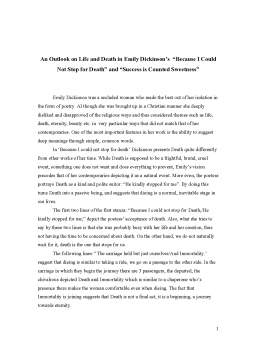Extras din seminar
Emily Dickinson was a secluded woman who made the best out of her isolation in the form of poetry. Al though she was brought up in a Christian manner she deeply disliked and disapproved of the religious ways and thus considered themes such as life, death, eternity, beauty etc. in very particular ways that did not match that of her contemporaries. One of the most important features in her work is the ability to suggest deep meanings through simple, common words.
In ‘Because I could not stop for death’ Dickinson presents Death quite differently from other works of her time. While Death is supposed to be a frightful, brutal, cruel event, something one does not want and does everything to prevent, Emily’s vision precedes that of her contemporaries depicting it as a natural event. More even, the poetess portrays Death as a kind and polite suitor: “He kindly stopped for me”. By doing this turns Death into a passive being, and suggests that dieing is a normal, inevitable stage in our lives.
The first two lines of the first stanza: “Because I could not stop for Death,/He kindly stopped for me;” depict the poetess’ acceptance of death. Also, what she tries to say by these two lines is that she was probably busy with her life and her creation, thus not having the time to be concerned about death. On the other hand, we do not naturally wait for it, death is the one that stops for us.
The following lines:” The carriage held but just ourselves/And Immortality.’ suggest that dieing is similar to taking a ride, we go on a passage to the other side. In the carriage in which they begin the journey there are 3 passengers, the departed, the chivalrous depicted Death and Immortality which is similar to a chaperone who’s presence there makes the woman comfortable even when dieing. The fact that Immortality is joining suggests that Death is not a final act, it is a beginning, a journey towards eternity.
The carriage’s slow march in the second stanza could suggest that the carriage is actually a hearse, and it’s slowly proceeding as to a funeral. On the other hand it could also suggest that Death has no concept of time. The woman states ‘ I had put away/My labor, and my leisure too,/For his civility’, which means that after dieing she is finally at rest, thus, there is no more need to be concerned about worldly matters.
The following stanza portray life’s path and it’s 3 stages. This is done using metaphors and the power of symbols. They first pass the school, where children play – this is childhood. The children are gathered in a ring, which could suggest the ring of life (birth/childhood ; maturity; old age; death ), the lines giving us a hint that this is the meaning behind the imagery. They next pass the “gazing grain” which stands for maturity and the “setting sun” which is old age.
In the 4th stanza there is a additional information regarding the sun, which is that the 3 do not pass it, but rather he passed them. This suggests that the woman is already dead and while in death there is no time, in the real, mortal world, nature continues to take it’s course.” The dews grew quivering and chill,/For only gossamer my gown,/My tippet only tulle.” symbolize two things: the chilling of the corps after death and the clothes suitable for funerals. It also strengthens the idea that the woman was taken by surprise by death and had no time to prepare, to dress for the journey.
They next pause by a house “that seemed/A swelling of the ground;/The roof was scarcely visible,/The cornice but a mound.” which symbolizes the grave while the sweeling represents the grave stone.
Preview document
Conținut arhivă zip
- An Outlook on Life and Death in Emily Dickinson's Because I Could Not Stop for Death and Success is Counted Sweetness.doc












